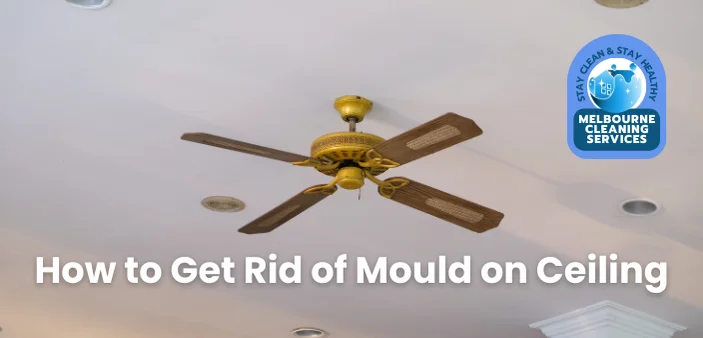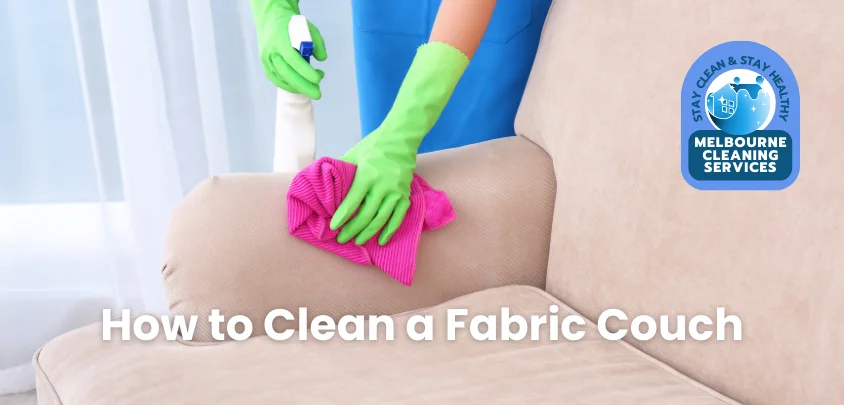How Mould is Bad for Your Health
First things first, let’s talk about why mould is such a big deal. Mould isn’t just ugly; it’s also bad news for your health. When mould spores are in the air, they can cause all sorts of problems, especially if you or anyone in your home has allergies, asthma, or a weakened immune system.
Common symptoms of mould exposure include:
- Coughing and sneezing
- Throat irritation
- Skin rashes
- Red or itchy eyes
- Nasal congestion
In severe cases, mould can trigger asthma attacks and lead to chronic respiratory issues. Long-term exposure can even affect the health of otherwise healthy individuals. That’s why it’s crucial to deal with mould as soon as you spot it.
Related Blog Essential Cleaning Strategies for Asthma Sufferers in Melbourne
How to Remove Mould from Ceiling
Getting rid of mould on your ceiling might seem like a daunting task, but don’t worry, we’ve got you covered with a step-by-step guide:
1. Safety First
Before you start, make sure you’re well-protected. Mould can be harmful, so wear gloves, goggles, and a mask to avoid inhaling spores or getting them on your skin. Trust us; safety gear is a must.
2. Ventilate the Area
Open up windows and doors to get some fresh air flowing. Proper ventilation helps to reduce humidity and prevent mould spores from spreading around your home.
3. Identify the Cause
Find out where the moisture is coming from. It could be a leaky roof, poor insulation, or just high humidity. Fixing this issue is crucial to prevent mould from coming back.
4. Prepare a Cleaning Solution
Depending on the severity of the mould, you can use different solutions:
a. Bleach Solution:
Mix one part bleach with three parts water. It’s effective but has strong fumes, so use it in a well-ventilated area.
b. Vinegar Solution:
Use undiluted white vinegar or mix it with water. It’s a natural, non-toxic option that works well for mild mould.
c. Commercial Mould Cleaners:
There are plenty of products out there designed specifically for mould removal. Follow the instructions on the label.
5. Apply the Solution
Spray your chosen solution onto the mouldy areas. If you’re using bleach or a commercial cleaner, let it sit for about 10-15 minutes to do its job. For vinegar, let it sit for at least an hour.
6. Scrub the Mould
Grab a scrub brush or sponge and gently scrub the mould off the ceiling. Don’t go too hard, or you might damage the surface. If you need to, apply more cleaning solution and scrub again.
7. Rinse and Dry
Use a damp cloth to wipe away any residue from the cleaning solution. Make sure to dry the area thoroughly to prevent moisture from causing more mould. A dry cloth or fan can help speed up the drying process.
8. Dispose of Contaminated Materials
Get rid of any sponges or clothes you used to clean the mould. Seal them in a plastic bag before throwing them away to stop mould spores from spreading.
9. Prevent Future Growth
Keep the area well-ventilated and reduce humidity levels. Use dehumidifiers, fix any leaks, and regularly check for signs of moisture or mould.
Extra Tips to Remove Mould from Bedroom Ceiling
Now, let’s get specific about removing mould from your bedroom ceiling. This can be particularly important since you spend a lot of time in your bedroom, and you don’t want to breathe in mould spores while you sleep.
Here are some additional tips to make the process easier and more effective:
Use Natural Light and Heat
Mould thrives in dark and damp conditions, so open your curtains and let sunlight into the room. If possible, use a space heater to dry out the room and reduce moisture levels.
Treat Stains After Cleaning
Even after removing the mould, stains may remain on your ceiling. To tackle these, mix baking soda with water into a paste, apply it to the stain, and gently scrub.
Use Anti-Mould Paint
After cleaning, consider applying an anti-mould paint or sealant to the ceiling. This creates a protective barrier that resists mould growth in the future.
Position Furniture Strategically
Ensure furniture isn’t placed too close to the walls, as this can restrict airflow and create a favourable environment for mould. Keep a small gap between the walls and large furniture pieces.
Monitor Humidity Levels
Bedrooms can accumulate moisture from activities like breathing or using humidifiers. Invest in a hygrometer to monitor humidity and keep it below 50% to inhibit mould growth.
Inspect Insulation
Poor insulation can cause condensation on ceilings, leading to mould. Ensure your attic or ceiling insulation is in good condition to prevent moisture buildup.
Schedule Regular Checks
Make it a habit to inspect your ceiling for signs of mould or moisture. Early detection can save you time and effort in dealing with widespread mould issues later.
Related Blog: How to Prevent Dust in Your Bedroom: 8 Pro Tips
How to Remove Mould from Painted Ceiling
Removing mould from a painted ceiling needs a bit of extra care so you don’t damage the paint. Here’s how to do it:
Apply Gentle Cleaning Solutions
Use a mild bleach solution or vinegar. Avoid abrasive cleaners as they can strip the paint off your ceiling.
Spot Test
Before you go all in, do a spot test. Apply the solution to a small, hidden area to make sure it doesn’t damage the paint.
Soft Scrubbing
Use a soft brush or sponge to gently scrub the mould. Don’t use too much force—you don’t want to ruin your paint job.
Rinse and Dry
Wipe the area with a damp cloth to remove any leftover cleaning solution. Make sure the ceiling is thoroughly dried to prevent mould from making a comeback.
5 Tips to Prevent Mould from Coming Back
Preventing mould from coming back is just as important as removing it. Here are some tips to help you keep your home mould-free:
Control Humidity Levels
Use dehumidifiers and air conditioners to keep humidity levels below 60%. This makes it harder for mould to grow.
Ventilate Your Home
Make sure your home is well-ventilated. Use exhaust fans in bathrooms and kitchens, and open windows whenever possible to let fresh air in.
Fix Leaks Promptly
Whether it’s a leaky roof, pipe, or window, fix any leaks as soon as you notice them. Moisture from leaks can lead to mould growth in no time.
Clean Regularly
Regular cleaning is essential to prevent mould growth, especially in moisture-prone areas like bathrooms and kitchens.
For a more thorough approach, consider hiring a professional cleaning company in Melbourne to perform deep cleaning of your home. Scheduling professional cleanings every three months can significantly reduce the risk of mould buildup and keep your living spaces healthier and fresher.
Use Mould-Resistant Products
When renovating or building, consider using mould-resistant products like mould-resistant drywall and paint.
Bonus Content: Top 10 Eco-friendly Cleaning Products
FAQs
What Causes Mould on the Ceiling?
Mould on ceilings is usually caused by excess moisture from leaks, poor ventilation, or high humidity. Fixing the source of moisture is key to preventing mould.
Can I Paint Over the Mould to Hide It?
No, painting over mould is a bad idea. The mould will keep growing underneath the paint, which can cause health problems and damage to your home. Always remove the mould first.
Is Bleach or Vinegar Better for Removing Mould?
Both have their uses. Bleach is strong and works quickly but can be harsh and have strong fumes. Vinegar is natural, non-toxic, and effective for milder mould. Choose based on your needs and the severity of the mould.
What Should I Do if the Mould Keeps Coming Back?
If mould keeps returning, it might be time to call in the professionals. Persistent mould issues could indicate a more serious underlying problem that needs to be addressed.
Can Mould Cause Permanent Damage to My Home?
Yes, if left untreated, mould can cause permanent damage to your home’s structure and materials. It can weaken walls, ceilings, and floors, leading to costly repairs.
Is Professional Mould Removal Worth It?
Absolutely. Professional mould removal services, like those offered by Melbourne Cleaning Services, ensure that mould is thoroughly removed and the source of moisture is addressed. This can save you time, money, and health issues in the long run.





